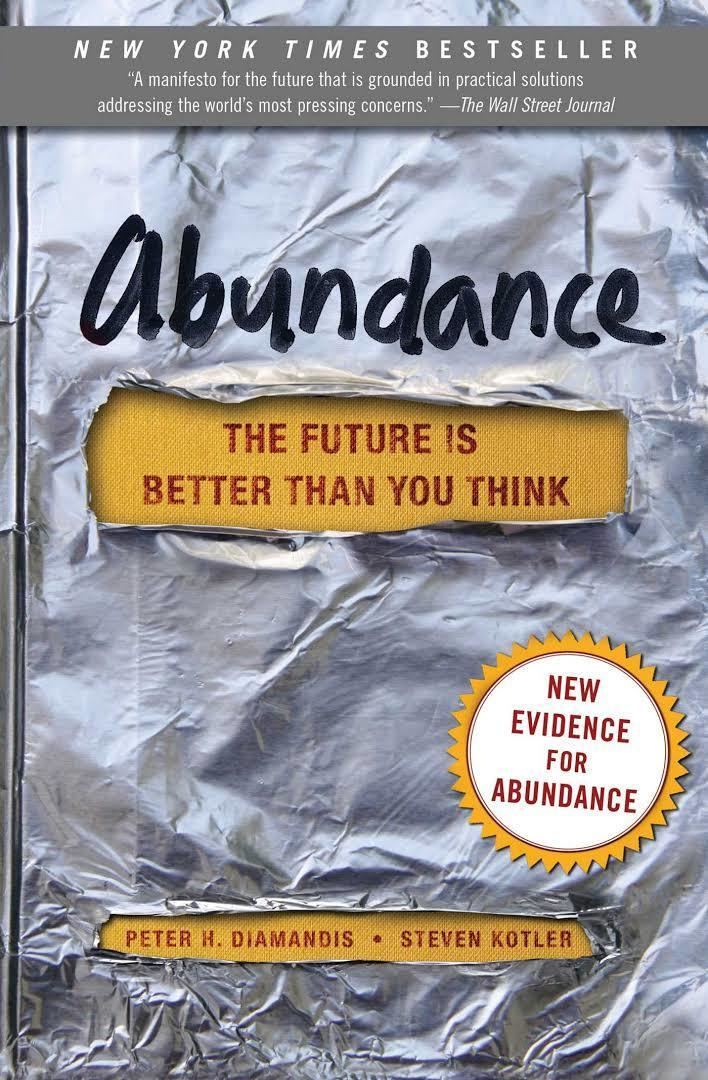7.8 /10 1 Votes7.8
3.8/5 Barnes & Noble Country United States Originally published 21 February 2012 ISBN 9781451614213 | 4.1/5 Goodreads Audio read by Arthur Morey (Audible) Subject Technology, Economics Genre Non-fiction | |||||||||||||||||||||||||||||||||
 | ||||||||||||||||||||||||||||||||||
Publication date February 21, 2012; March 28, 2012 (Audible) Pages 386 pp. (first edition), 10 hrs and 22 mins (Audible) Nominations Goodreads Choice Awards Best Nonfiction Similar Innovation books, Non-fiction books | ||||||||||||||||||||||||||||||||||
Peter diamandis steven kotler on abundance the future is better than you think
Abundance: The Future Is Better Than You Think is a book by Peter H. Diamandis and Steven Kotler that was published in 2012. The writers refer to the book's title as being a future where nine billion people have access to clean water, food, energy, health care, education, and everything else that is necessary for a first world standard of living, thanks to technological innovation.
Contents
- Peter diamandis steven kotler on abundance the future is better than you think
- Abundance the future is better than you think audiobook sample
- Theme
- Synopsis
- Table of contents
- Reception
- References
The book was a commercial success. It debuted at #1 on both Amazon.com and Barnes & Noble's bestseller lists. Praise appeared in various publications such as Time and The Washington Post.
Abundance the future is better than you think audiobook sample
Theme
The book's four main points are:
- Technologies in computing, energy, medicine and many other areas are improving at an exponential rate and will soon enable breakthroughs that today seem impossible.
- These technologies have allowed independent innovators to achieve startling advances in many areas of technology with little money or manpower. This is primarily achieved through incentive prize competitions.
- Technology has created a generation of "techno-philanthropists" (such as Bill Gates) who are using their billions to try to solve seemingly unsolvable problems such as hunger and disease.
- The lives of the world's poorest people are being improved substantially because of technology.
Synopsis
The book is divided into six parts: Perspective, Exponential Technologies, Building the Base of the Pyramid, The Forces of Abundance, Peak of the Pyramid, and Steering Faster. It contains 19 chapters, a reference section with raw data, an appendix titled "Dangers of the Exponentials," and a Notes section for further reading.
Table of contents
Reception
The book was largely well received by critics. Abundance was profiled in Time magazine, the Washington Post, the San Francisco Chronicle and the Wall Street Journal. It debuted at #1 on both Amazon.com and Barnes & Noble's bestseller lists, and at #2 on the New York Times bestseller list. It remained on the NYT bestseller list for nine weeks.
Time wrote of its message, "The future is going to be better than you think. That might be hard to believe given the constant stream of dread that is the daily news -- and the endless well of fear that seems to be the future -- but a close look at the numbers indicates that things are better than we believe."
The Washington Post added that the book is "a heavy dose of optimism... The authors make a persuasive case that mankind's future may not be as bleak as we fear."
The San Francisco Chronicle said that the book's authors "argue forcefully against two prevailing notions: that the world's resources are being depleted too rapidly, and that the gap between the rich and the poor is widening beyond repair. They cite the rise of do-it-yourself innovation, fabulously rich 'technophilanthropists' who intend to use their deep pockets to change the world, and what they've termed the 'rising billion': the world's poor, who, thanks to modern communication technology, now have a voice."
The Wall St. Journal wrote, "Diamandis and Kotler think that individual innovators can and will make huge differences to human living standards... Take Iqbal Quadir, who quit his job as a venture capitalist in New York to start a cellphone company in his native Bangladesh, at a time when cellphones cost nearly twice the annual income of the average Bangladeshi. He had the foresight to bet on falling costs and the usefulness of the new technology for the long-isolated rural poor."
It should also be pointed out that the book was not universally acclaimed. In particular, see Timothy Ogden's review in the Stanford Social Innovation Review, where he describes the book as "...techno-utopianism at its worst".
